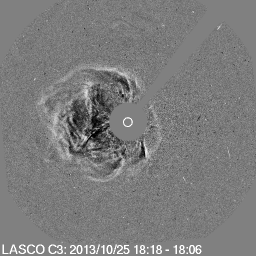
@adamfinley.bsky.social
@AdamF_Astro
Followers
2K
Following
4K
Media
401
Statuses
879
ESA Research Fellow at ESTEC. Investigating the Sun's magnetic activity, solar wind connection science, and the spin-down of Sun-like stars. Prev. CEA, Exeter.
Noordwijk, Netherlands
Joined June 2012
Solar Orbiter Nugget @esascience about our recent active region nest study. We used Solar Orbiter as a far side observer from April to October 2022 to survey magnetic activity over the entire solar surface. This shed light on the nesting of active regions: https://t.co/LwBJl6cd8r
0
2
13
Published in @AandA_journal 😍:
Side project day! NASA's Parker Solar Probe (PSP) has been exploring the near-Sun enviroment since the start of solar cycle 25. Now passing maximum activity, how has the shape and size of the Sun's Alfvén surface evolved since? https://t.co/RaaJElhRCH (1/5)
0
0
2
The Alfvén radius is linked to the solar wind mass and magnetic flux. The wind magnetisation parameter (~ratio of mag/mass flux), is used to understand this scaling. Our results follow the trends from MHD wind simulations, but had an offset due to 3D effects and turbulence. (5/5)
0
0
3
The evolution of the coronal magnetic field during the solar cycle, strongly influenced the magnetic connectivity of PSP. Near minimum, the wind measured by PSP originated closer to the Sun's poles. Towards maximum activity, wind sources moved towards the active latitudes. (4/5)
1
1
7
We mapped the wind back to its source using the Parker spiral and a potential field source surface model. The Alfvén surface was modulated by structure in the corona. Smaller near current sheets and pseudo-streamers, larger near the dipole axis and expanding magnetic field. (3/5)
1
0
3
Using hourly measurements from the SWEAP and FIELDS suites, we mapped PSP to the Alfvén surface with a Parker spiral. Each encounter had a distribution of radii. The longitudinal-average reduced the bias from individual wind streams, the average grew from 10-16 solar radii. (2/5)
1
0
1
Side project day! NASA's Parker Solar Probe (PSP) has been exploring the near-Sun enviroment since the start of solar cycle 25. Now passing maximum activity, how has the shape and size of the Sun's Alfvén surface evolved since? https://t.co/RaaJElhRCH (1/5)
1
2
8
New paper day! Metcalfe et al. review the evidence for weakened magnetic braking by homogenizing the stellar parameters from previous studies that constrained the wind braking of stars with observed magnetic fields and x-ray fluxes (proxy for mass-loss): https://t.co/nAlZyPvlks
0
0
10
Looking at this swirling feature in the solar atmosphere, revealed that the viscous heating along the swirl boundary was linked with the breakdown of coherent oscillations in the swirl. This method provides a new pathway to investigate wave activity in the solar atmosphere. (4/4)
0
0
2
Using this approach, horizontal slices of a realistic solar atmosphere were decomposed into their most significant frequencies. A biproduct of this method, the highest frequency bin highlights dissipation/shocks. This is especially clear at swirl boundaries. (3/4)
1
0
3
The MSF/W method uses discrete Fourier transforms to move variables into frequency/wavenumber space and identify the most significant contribution to that variable at a given time/place. An example of a signal decomposed into the most and 2nd most significant wavenumbers. (2/4)
1
0
1
New paper day! 🔥 George Cherry et al. develop the Most Significant Frequency/Wavenumber method for detecting wave activity in realistic magnetohydrodynamic simulations of the Sun's atmosphere. Published in A&A: https://t.co/60XHhDNJOM (1/4)
1
0
4
A gorgeous prominence eruption that took place this morning. This animation shows the benefit of EUV imagers with larger fields of view. SUVI on GOES was designed and built by the team I belong to.
6
144
436
Solar Orbiter Hackathon, 17–21 November 2025 at ESA/ESTEC (Noordwijk, NL). 20 ECRs (PhD and postdoc) will form 5 teams lead by mentors. This is a great chance to connect and collaborate on Solar Orbiter science! For more information: https://t.co/3dqn4qjXts Deadline: 5th Sept.
cosmos.esa.int
0
4
7
Here's a comparison of the coronal magnetic field from solar minimum (Dec 2019) and now at solar maximum. The dipole component of the Sun's magnetic field is visibly inclined to the rotation axis.
0
4
10
Observe the stability of the positive-negative sectors over the last five rotations, with two nested active regions (black contours) anchoring the heliospheric current sheet. Solar flares are shown with coloured markers. The dipole axis just started to move away from the equator.
1
0
7
At present, the Sun's magnetic field is well-described by an inclined dipole, with coronal holes at the positive and negative dipole axis. It's been like that for a year. Solar Orbiter's path would cut across a large positive coronal hole twice around 60 degrees Car. longitude.
1
0
4
What might we expect to see during @ESASolarOrbiter's upcoming remote-sensing windows; now with an inclined orbit. Here's the PFSS connectivity during the remote-sensing window of spring 2026 (17th Feb to 6th Mar), using the current coronal magnetic field and in-situ wind speeds.
1
5
18
The effect this has on stellar spin-down was explored using the stellar wind braking torques from Finley & Matt 2018. The ratio of the torque using each ZDi map versus the activity-Rossby relation showed that they can be underestimated by an order of magnitude or more. (4/4)
0
0
2
The magnetic fields of slowly rotating fully-convective stars, square markers, diverge from the activity-Rossby (rotation/turnover) relation of Sun-like stars. Stronger magnetic field strengths suggest different mechanisms are at work in partially vs fully-convective stars. (3/n)
1
0
2
Slowly rotating low-mass stars are challenging to observe with the ZDi technique, so we previously lacked the information to constrain the properties of the convective dynamos in these stars. This work now includes these stars, shown in red, in the sample of 96 stars. (2/n)
1
0
1

